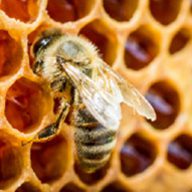Honey Bees
Predominantly golden-yellow with light brown or black bands; hair is most noticeable on the thorax; oval in shape with varying dark-to-light striations; around 1/2 inch in length

Diet: Honey bees forage and collect nectar and pollen from a variety of flowers and plants, which is gathered and brought back to feed larvae and other members of the colony.
Habitat: Often their nests are built in tree crevices but are occasionally found in attics or chimneys with colonies in the thousands as they are a social species. Each hive has a queen which produces around 2,000 eggs a day. Honey bees will swarm when their colony becomes too large for its hive.
Threats: While honey bees do sting, only females are capable of stinging and can only do so once. They are not likely to sting while foraging for nectar and pollen. As docile bees, they rarely strike unless provoked. Honey bee stingers have barbs that require physical removal from the skin otherwise it will remain. Their stings are quite painful and some people are allergic. As with all bee species, contact a pest control company if you suspect a hive or infestation.
Control: It’s important to remember that honey bees are the most active and important species of pollinators and are critical to the environment and the food supply, so it is best to contact a pest control company if you suspect a nest. To prevent bees from settling into your home or yard, make sure your chimney is properly covered, caulk holes or cracks that are visible, remove debris from around your property and use fitted lids on garbage cans.
